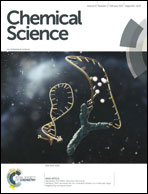A supramolecular Tröger's base derived coordination zinc polymer for fluorescent sensing of phenolic-nitroaromatic explosives in water†
Abstract
A V-Shaped 4-amino-1,8-napthalimide derived tetracarboxylic acid linker (L; bis-[N-(1,3-benzenedicarboxylic acid)]-9,18-methano-1,8-naphthalimide-[b,f][1,5]diazocine) comprising the Tröger's base (TB) structural motif was rationally designed and synthesised to access a nitrogen-rich fluorescent supramolecular coordination polymer. By adopting the straight forward precipitation method, a new luminescent nanoscale Zn(II) coordination polymer (TB-Zn-CP) was synthesized in quantitative yield using Zn(OAc)2·2H2O and tetraacid linker L (1 : 0.5) in DMF at room temperature. The phase-purity of as-synthesised TB-Zn-CP was confirmed by X-ray powder diffraction analysis, infra-red spectroscopy, and elemental analysis. Thermogravimetric analysis suggests that TB-Zn-CP is thermally stable up to 330 °C and the morphological features of TB-Zn-CP was analysed by SEM and AFM techniques. The N2 adsorption isotherm of thermally activated TB-Zn-CP at 77 K revealed a type-II reversible adsorption isotherm and the calculated Brunauer–Emmett–Teller (BET) surface area was found to be 72 m2 g−1. Furthermore, TB-Zn-CP displayed an excellent CO2 uptake capacity of 76 mg g−1 at 273 K and good adsorption selectivity for CO2 over N2 and H2. The aqueous suspension of as-synthesized TB-Zn-CP showed strong green fluorescence (λmax = 520 nm) characteristics due to the internal-charge transfer (ICT) transition and was used as a fluorescent sensor for the discriminative sensing of nitroaromatic explosives. The aqueous suspension of TB-Zn-CP showed the largest quenching responses with high selectivity for phenolic-nitroaromatics (4-NP, 2,4-DNP and PA) even in the concurrent presence of other potentially competing nitroaromatic analytes. The fluorescence titration studies also provide evidence that TB-Zn-CP detects picric acid as low as the parts per billion (26.3 ppb) range. Furthermore, the observed fluorescence quenching responses of TB-Zn-CP towards picric acid were highly reversible. The highly selective fluorescence quenching responses including the reversible detection efficiency make the nanoscale coordination polymer TB-Zn-CP a potential material for the discriminative fluorescent sensing of nitroaromatic explosives.



 Please wait while we load your content...
Please wait while we load your content...